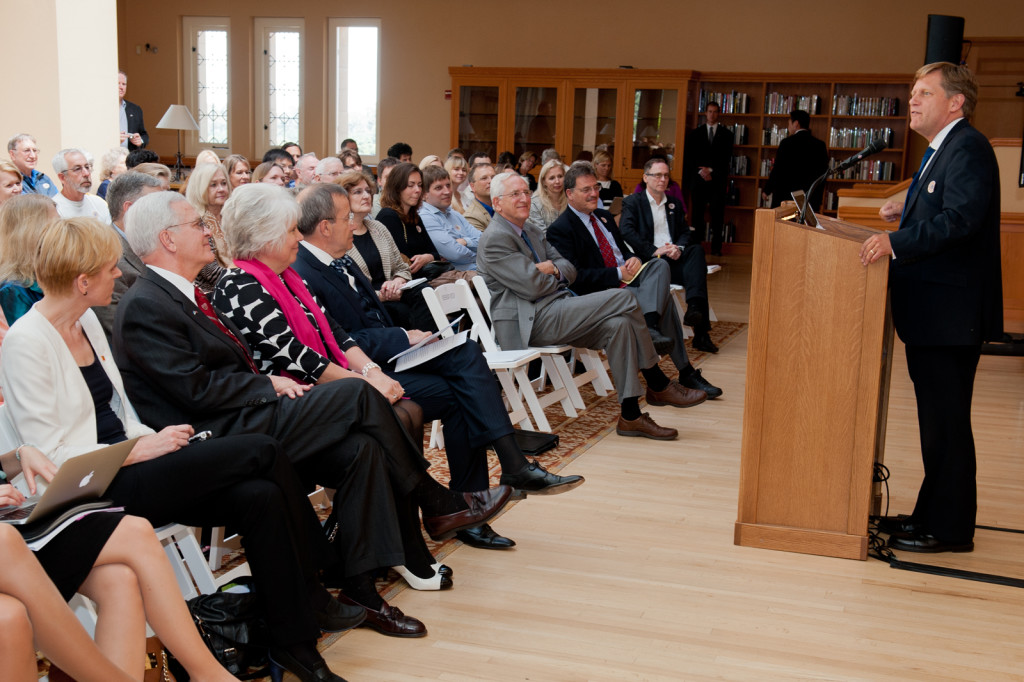Most of us couldn’t find Estonia on a map – even though the Ukrainian crisis has brought the Baltic states into sharper focus. It’s too bad, because there’s so much to know and like about Estonia. For one, it’s the Silicon Valley of Europe – Skype came from this tiny country of 1.3 million, and they do taxes online and vote online from their laptops. (I’ve written about a few of its other good points here and here and here.)
Another reason to like it is President Toomas Hendrik Ilves, who spoke at Stanford last week, wearing his signature bow tie. The New Jersey-reared and American-educated former journalist has been president of Estonia for eight years, and in public life for decades prior to that. He also had a famous Twitter spat with Nobel economist Paul Krugman two years ago; we wrote about it here. Although he learned computer programming at 13, he insists “I am not a geek.”
Ilves was at Stanford to discuss “the fundamental issue of our time” – the future of the digital world. “We are probably the most wired country in the world,” he said of his tiny homeland. By contrast, America’s record as the land of invention is outstanding – “but using IT to make the life of people better? Not so good.”
He recommended “digital ID card” that would provide a unique identity to everyone, and is legally equivalent to a signature. “Unless you have a guaranteed ID, anything can happen,” he said. The Estonians borrowed the concept from the neighboring Finns, but took it a little farther.
He also told the story of Estonia’s remarkable post-Soviet recovery – which itself offers a perspective on current events in Eastern Europe. Estonia suffered three occupations in the 20th century: first the Soviet Union in 1939, then the Nazis in 1941, then the Soviet Union again from 1944 until 1993. (How did it end? Cf. my post on The Singing Revolution here).
At the time of their independence, Ilves said, the nation hadn’t built any new highways or overpasses in 50 years. Estonia had a 1938 phone system. Their good friends, the neighboring Finns, were upgrading in 1993, and offered the Estonians their “legacy technology” from 1979. Definitely an improvement. Ilves urged Estonia to refuse the offer, and it did. With commitment and will, he said, they had a thoroughly up-to-date digital system within six months. Ilves explained that when he was ambassador to Washington, he had a worse phone connection to the State Department two miles away than he did to Tallinn, 5,000 miles away. By 1998, “all our kids were hooked up with computers in schools.”
 It’s easy to feel overwhelmed when you’re in a small country on the periphery, and the economies of scale are working against you. “If you don’t have scale, you get kind of suicidal,” he joked. He changed his mind about the possibilities when he read Jeremy Rifkin‘s 1995 The End of Work. He explained that story in the Wall Street Journal here.
It’s easy to feel overwhelmed when you’re in a small country on the periphery, and the economies of scale are working against you. “If you don’t have scale, you get kind of suicidal,” he joked. He changed his mind about the possibilities when he read Jeremy Rifkin‘s 1995 The End of Work. He explained that story in the Wall Street Journal here.
Ilves declined to talk about the topic that was on everyone’s mind: Russian aggression in Ukraine. As former U.S. ambassador to Russia Michael McFaul explained in his introduction, “If you want to understand Russia today, you have to follow Ilves on Twitter – and do it today. There’s no greater authoritative voice about our current crisis.”
You can do that right now, right here. I did, about the time of the Krugman spat. Meanwhile, we’re told there will be a youtube video of the event at Stanford Libraries any moment now. We’ll post it as soon as we receive word. Promise.
UPDATE on 5/30: We promised you the YouTube video … and heeeeerrrrrreee it is!



